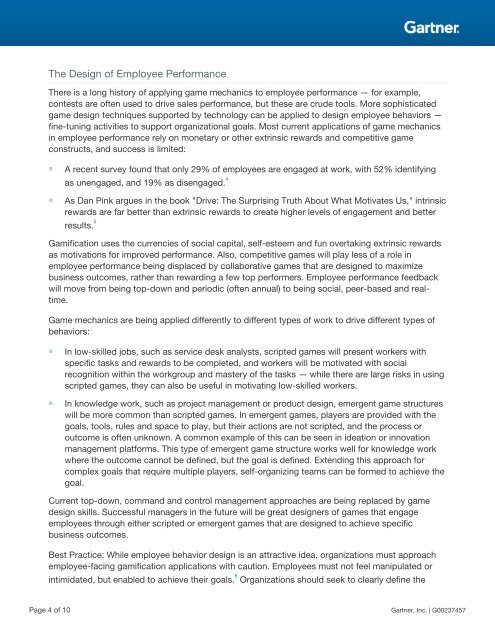Gamification 2020: What Is the Future of Gamification?
Gamification 2020: What Is the Future of Gamification?
Gamification 2020: What Is the Future of Gamification?
Create successful ePaper yourself
Turn your PDF publications into a flip-book with our unique Google optimized e-Paper software.
The Design <strong>of</strong> Employee Performance<br />
There is a long history <strong>of</strong> applying game mechanics to employee performance — for example,<br />
contests are <strong>of</strong>ten used to drive sales performance, but <strong>the</strong>se are crude tools. More sophisticated<br />
game design techniques supported by technology can be applied to design employee behaviors —<br />
fine-tuning activities to support organizational goals. Most current applications <strong>of</strong> game mechanics<br />
in employee performance rely on monetary or o<strong>the</strong>r extrinsic rewards and competitive game<br />
constructs, and success is limited:<br />
■ A recent survey found that only 29% <strong>of</strong> employees are engaged at work, with 52% identifying<br />
as unengaged, and 19% as disengaged. 4<br />
■ As Dan Pink argues in <strong>the</strong> book "Drive: The Surprising Truth About <strong>What</strong> Motivates Us," intrinsic<br />
rewards are far better than extrinsic rewards to create higher levels <strong>of</strong> engagement and better<br />
results. 5<br />
<strong>Gamification</strong> uses <strong>the</strong> currencies <strong>of</strong> social capital, self-esteem and fun overtaking extrinsic rewards<br />
as motivations for improved performance. Also, competitive games will play less <strong>of</strong> a role in<br />
employee performance being displaced by collaborative games that are designed to maximize<br />
business outcomes, ra<strong>the</strong>r than rewarding a few top performers. Employee performance feedback<br />
will move from being top-down and periodic (<strong>of</strong>ten annual) to being social, peer-based and realtime.<br />
Game mechanics are being applied differently to different types <strong>of</strong> work to drive different types <strong>of</strong><br />
behaviors:<br />
■ In low-skilled jobs, such as service desk analysts, scripted games will present workers with<br />
specific tasks and rewards to be completed, and workers will be motivated with social<br />
recognition within <strong>the</strong> workgroup and mastery <strong>of</strong> <strong>the</strong> tasks — while <strong>the</strong>re are large risks in using<br />
scripted games, <strong>the</strong>y can also be useful in motivating low-skilled workers.<br />
■ In knowledge work, such as project management or product design, emergent game structures<br />
will be more common than scripted games. In emergent games, players are provided with <strong>the</strong><br />
goals, tools, rules and space to play, but <strong>the</strong>ir actions are not scripted, and <strong>the</strong> process or<br />
outcome is <strong>of</strong>ten unknown. A common example <strong>of</strong> this can be seen in ideation or innovation<br />
management platforms. This type <strong>of</strong> emergent game structure works well for knowledge work<br />
where <strong>the</strong> outcome cannot be defined, but <strong>the</strong> goal is defined. Extending this approach for<br />
complex goals that require multiple players, self-organizing teams can be formed to achieve <strong>the</strong><br />
goal.<br />
Current top-down, command and control management approaches are being replaced by game<br />
design skills. Successful managers in <strong>the</strong> future will be great designers <strong>of</strong> games that engage<br />
employees through ei<strong>the</strong>r scripted or emergent games that are designed to achieve specific<br />
business outcomes.<br />
Best Practice: While employee behavior design is an attractive idea, organizations must approach<br />
employee-facing gamification applications with caution. Employees must not feel manipulated or<br />
intimidated, but enabled to achieve <strong>the</strong>ir goals. 6<br />
Organizations should seek to clearly define <strong>the</strong><br />
Page 4 <strong>of</strong> 10 Gartner, Inc. | G00237457


